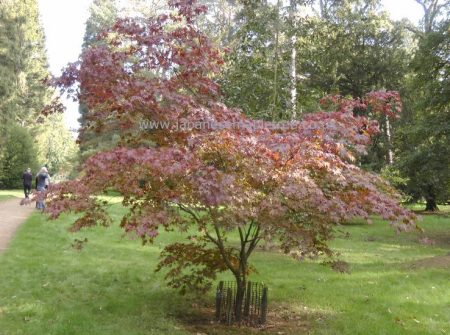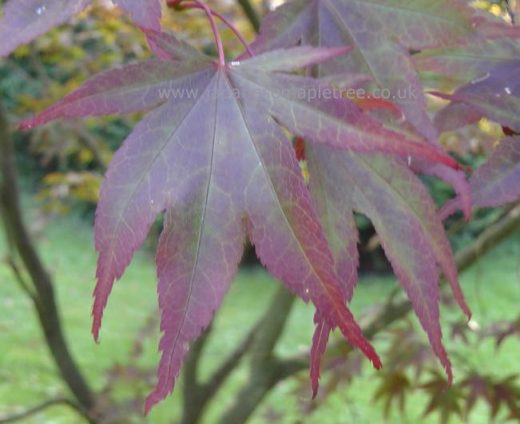JAPANESE MAPLE BLOODGOOD
Article and pictures by David Marks.
One of the most common Japanese Maples, Bloodgood grows to about 6m / 20ft in most conditions but can grow to 10m / 33ft in perfect conditions. It is one of the few Japanese Maples to have been awarded the RHS Award of Garden Merit.
In general this is one of the best red-leaved varieties available, even today. Many specimens have been successfully grown from cuttings.
KEY FEATURES OF ACER PALMATUM BLOODGOOD
| Genus | Acer |
| Species | palmatum |
| Variety | ‘Bloodgood’ |
| Light | Most conditions are suitable |
| Hardy | Yes |
| Soil | Slightly acidic and well-drained |
| Height | 6m / 20ft after 20 years |
| Spread | 6m / 20ft after 20 years |
| Shape | Round canopy as wide as it is tall |
| Colour | Green turning to bright crimson in the autumn / fall. Holds its colour well. |
| Bonsai | No |
LEAF AND TREE FORM
The leaves turn a deep crimson in autumn although the underside of the leaves remains bright green throughout the year.
Normally the leaves have seven lobes, each tapering to a fine point. The edges are lightly serrated. The stalks are bright red as are the autumn fruits.
CULTIVATION OF ACER PALMATUM ‘BLOODGOOD’
POSITION
Acer japonicum ‘Bloodgood’ prefers a slightly acidic soil which is well drained but not dry. Ideally they should be in a partial shade position but a full sun position in cooler areas is also ideal.
PRUNING
When the tree is approaching the size you require, prune annually after leaf fall in late November to very early January in UK weather conditions. Choose a dry day. Don’t paint over the wounds, leave them to dry off naturally and quickly. A sharp and clean pair of secateurs is the ideal tool.
In older trees (five years and older) prune away some of this twiggy growth in the centre of the tree if it is becoming congested. This will allow good air circulation and help prevent fungal infections.
The main trunk of Bloodgood often looks better when the lower stems are pruned away to expose the bark. If you wish to do this start in year five of the tree’s life.
FEEDING AND WATERING
Avoid feeding this variety of Japanese Maple, it will be able to absorb sufficient nutrients on its own. Excessive nutrients in the soil cause soft growth which will be liable to frost damage in the winter.
In the first two years of its life water the tree if conditions become dry. After that only water if there is a significant drought. A mulch of well rotted compost or similar around the base of the tree will reduce water loss and maintain an even supply.
For more comprehensive details about caring for your Japanese Maple tree
click here.
SUPPLIERS OF BLOODGOOD
This is one of the most readily available of the Japanese maples and is stocked by numerous online suppliers as well as most garden centres.

